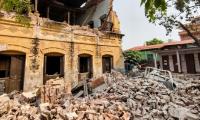Last week, Punjab University announced a major decision that went almost unnoticed due to the election fervour. The university administration reduced the quota allocated to Baloch students from 100 seats to 53, a reduction of almost 50 percent. Moreover, the admissions will now go through the Balochistan government, which will “nominate” students for these scholarships to the Higher Education Commission.
There is growing concern among Baloch and Pashtun students that this is part of a larger trend to seal the brief window of opportunity opened for students from Pakistan’s most deprived province. Two salient lines of argument against the quota system need to be deconstructed before demonstrating the sinister motives behind this move.
The first argument against quotas is a defence of ‘meritocracy’ – ie that students from Balochistan should enter the university based on open merit rather than through fixed seats. What such an argument misses is that inequality and uneven development are integral features of modern societies, with many regions sacrificed at the altar of ‘national development’. The quota system is recognition of this unevenness in the social body and an attempt to overcome it through affirmative action. Without levelling a field that has been distorted through a history of exploitation, pursuit of ‘meritocracy’ only becomes a cloak for reproducing privilege, and further marginalises those on the peripheries.
One should also keep in mind that almost all American, Canadian and Indian universities have quotas for people from underprivileged ethnic, religious or caste backgrounds; such quotas have benefitted these institutions through the diversity of opinions brought in by such students. Hence, the reservation of 100 seats for Balochistan in a university of 40,000 students cannot be seen as an exceptional act of kindness on the part of the PU administration. One should also remember that the genesis of Muslim nationalism, and hence the genesis of Pakistan, lies in the demand for separate electorates, one of the earliest manifestations of the quota system in the modern world. It is astonishing to see how selective amnesia functions to preserve the power of the privileged.
The second and perhaps more sinister argument is that Baloch and Pashtun students are the reason for persistent outbreaks of violence on campus and therefore their numbers should be reduced. This argument, apart from being obviously racist, is completely ahistorical. Punjab University has had a reputation for violent clashes at least since the 1970s, well before the era of ethnic councils. The latest decision to scapegoat councils for the incompetence of the university and the higher education system in preventing violence on campus stems from a clash between the Pashtun Council and the Islami Jamiat Taleba in January 2018.
Since I was an assistant professor in the department where the clash took place, I was made part of the consultative process to deal with the recurrent outbreaks of violence on campus. Part of the task of resolving a long recurring problem is not to jump to swift conclusions, but to examine whether we are posing the right questions. My recommendations were against a high-handed response, since it is my firm belief that students are prone to violent conflicts because of the structural conditions in which they are receiving their education.
The extraordinarily large size of each class, the lack of sufficient permanent faculty members who can work with students outside the classrooms, the absence of psychological aid centres and career counselling, and an active repression of platforms for students to voice their grievances produce the alienating context behind this violence. If the university was able to listen to these students rather than criminalising dissent, and spent more resources on overhauling the education system rather than on finding scapegoats, one could slowly start seeing a resolution of the crisis that has plagued the university for decades.
Instead, within 48 hours, there was a complete reversal from the initial discussion that had begun at the vice chancellor’s office. In a classic mix of paranoia and short-termism, the issue was framed as a conspiracy by “separatists”, involving hostile foreign agencies. This absurd narrative was not being propagated by some teenage blogger, but by those running the country’s premiere university. Soon, no one from the faculty was being invited for consultative meetings, as the administration decided to resolve the matter by working with security and law-enforcement personnel. The stage was set for veiling the failure of the education system under the guise of ‘national security’.
Posing the wrong questions meant that power was handed to the coercive apparatus of the state, which is least qualified to assess the problems of the education system. Consequently, a list of ‘problematic’ students was hurriedly drawn up, terrorism charges were brought against them, and over 30 students were removed from the university. This decision turned out to be a media gimmick, as all the students were reinstated within a few months. However, it was agreed in the corridors of power that the source of all violence were the Baloch and Pashtun students, and that their numbers had to be drastically reduced.
To undertake this hastily-imagined plan, Sarfraz Bugti, the former interior minister of Balochistan, was flown into Lahore to negotiate with the university administration. Rather than representing the interest of students from his province, he simply parroted the obvious lies of a foreign plot at PU, and agreed to a reduction in quotas, granting a veneer of legitimacy to the administration. In return for displaying excessive loyalty, the Balochistan government won the right to “nominate” the students from Balochistan to the federal government after “vetting” their backgrounds. In other words, not only does such a policy reek of increasing nepotism, but it also aims to make conformity with the state’s ideological narrative a necessity for pursuing higher education.
Ironically, the vice chancellor who took these decisions for preserving ‘national security’ was himself dismissed from his office due to corruption charges. Yet, the main scandal is that the basic architecture of corruption and nepotism that haunts our university system remains intact, and is now cloaked by a language of security. Students, irrespective of their ethnic or ideological backgrounds, are repeatedly scapegoated, replacing meaningful change with spectacles of harsh action.
The reason we should not view this situation as merely a Pashtun or Baloch issue is because, beneath the ethnic card and punitive actions, the entire student body is suffering the impacts of a corrupt educational system. Moreover, the use of treason charges against students further restricts the freedom of dissent on campuses, and hands over disproportionate power to those institutions that should not influence decisions pertaining to education.
The new PTI government has an opportunity to demonstrate that it cares about the federation by reversing this discriminatory policy. The rest of us have a duty to fight these retrogressive policies, which only perpetuate a system that aims to merely tolerate students as obedient zombies. The outcome of such efforts will decide whether our universities become sites for critical and innovative thinking in the wake of challenging times, or whether they continue to become the ironic embodiment of the slow death of reason.
The writer is an historian and a member of the Haqooq-e-Khalq Movement.
Email: ammarjan86@gmail.com
Critics argue that strategy is vague, but closer look indicates strategic alignment with global trends and national...
To defeat it, we must distrust bot-driven narratives, to defeat it, we must verify sources before believing or sharing
Too often in emerging markets, digital innovation is treated as standalone goal, with risk relegated to afterthought
As in Pakistan lawfare’s impact and prevalence are increasing, situation is turning murkier
Number of traditions are associated with Eid, such as new clothes and giving and receiving of cash gifts as Eidi
Internationally, there have been misleading theories propounded about so-called slowing of Chinese economy







